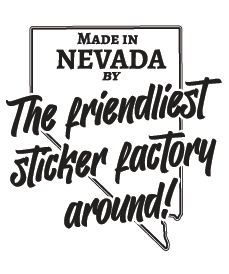Pick Your Adhesive
Pressure-sensitive label adhesives fall into three basic types, based on the chemical compounds used to make them: hot melt, solvent, and emulsion. Hot melt adhesives (those on most of our products) are rubber-based, handle cold and moisture very well, and stick easily to most prepared surfaces. They're widely used for labeling in many industries due to their broad range of applications, strength of adhesion, and temperature tolerance.
Solvents are made of acrylics in a petroleum-based matrix. They're durable, resisting chemical corrosion and physical shearing forces very well. Finally, emulsions are water-based adhesives that bind easily to most surfaces.
Hot melts are used for most applications due to their adaptability. They adhere to cardboard (including recycled cardboard), as well as most plastics, including "low surface energy" types like high density polyethylene (HDPE). They'll even stick to rough and highly textured surfaces that most adhesives spurn. Best of all, they're great for use in coolers and freezers, where they remain robust in the face of cold temperatures and moisture.
Considerations(1 mm at the minimum)
You may have special requirements for your labels, especially if you're applying them by hand. First of all, do they need to be removable? If you're using a permanent label, it can't be removed without damaging the label and/or the surface it's stuck to. If it goes on crooked, you're out of luck. Repositionable labels, however, can be removed if necessary and reapplied without causing any damage. Next, how fast will the labels be applied? This applies mostly with machine-applies labels, since speed isn't really an issue with hand-applying labels. How much stress can the label handle during fast application? Can the labels be repositioned if necessary?
You also have to take into account the conditions while labeling. Is the surface clean? How moist or humid is the environment? Is the room dusty or dirty? Are these intended as freezer or cooler labels, or do you plan to use them outdoors, or in high-heat environments? Will the labels have to deal with chemical exposure, UV exposure, sterilization, or abrasion? Very cold temperatures may require emulsion rather than hot melt adhesives.
Then there's the substrate itself. The composition can affect the bond strength of the adhesive, so what is the surface made of? Is it low- or high-energy? Low surface energy materials, like HDPE, require special adhesives to adhere smoothly. Different plastics also support different levels of adhesion, and again, texture is also important. Generally, the rougher the texture, the less contact with the adhesive. Also, how does the surface in question respond to cold temperatures?
The shape of the surface is also important. You have to consider the thickness and stiffness of the label here, because curved surfaces make adhesion more difficult in this case; they need thinner, more flexible base materials. above 160ºF- Incidental solvent exposure




